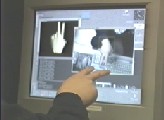

View-independent Hand Posture Recognition
Since human hand is highly articulated and deformable, hand posture recognition is a challenging example in the research of view-independent object recognition. Due to the difficulties of the model-based approach, the appearance-based learning approach is promising to handle large variation in visual inputs. However, the generalization of many proposed supervised learning methods to this problem often suffers from the insufficiency of labeled training data. This paper describes an approach to alleviate this difficulty by adding a large unlabeled training set. Combining supervised and unsupervised learning paradigms, a novel and powerful learning approach, the Discriminant-EM (D-EM) algorithm, is proposed in this paper to handle the case of small labeled training set. Experiments show that D-EM outperforms many other learning methods. Based on this approach, we implement a gesture interface to recognize a set of predefined gesture commands, and it is also extended to hand detection. This algorithm can also apply to other object recognition tasks.
 |
 |
| Realistic hand animation (8.2M, mpg) | paper-rock-scissors demo (3.1M, mpg) |
[1] Ying Wu and Thomas S. Huang, "View-independent Recognition of Hand Postures", In Proc. IEEE Conf. on Computer Vision and Pattern Recognition (CVPR'2000), Vol.II, pp.88-94, Hilton Head Island, SC, June, 2000. [PDF]
[2] Ying Wu and Thomas S. Huang, "Self-supervised Learning for Visual Tracking and Recognition of Human Hand", In Proc. AAAI 17th National Conf. on Artificial Intelligence (AAAI'2000), pp.243-248, Austin, TX, 2000. [PDF]
[3] Ying Wu, Kentaro Toyama and Thomas S. Huang, "Self-Supervised Learning for Object Recognition Based on Kernel Discriminant-EM Algorithm", in Proc. IEEE Int'l Conf. on Computer Vision (ICCV'01), Vol.I, 275-280, Vancouver, Canada, July, 2001. [PDF]
Return to HCI Research
Updated 09/2000. Copyright © 2001-2003 Ying Wu